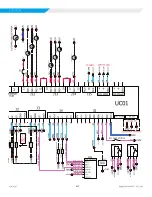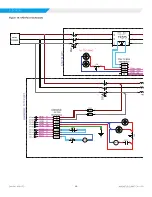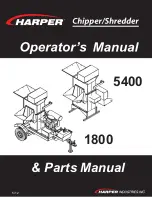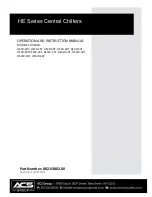
INSTALLATION
MAGNITUDE WMT CHILLER
DAIKIN APPLIED
8
damage and loss of charge during storage, the customer can
have the charge removed and stored in recovery cylinders.
CAUTION
If the temperature of where the chiller is located is expected
to exceed 113°F (45°C), then the refrigerant must be removed.
It is necessary to observe some precautions during storage.
•
Do not leave the unit exposed to weather elements
•
Do not expose the unit to direct sunlight
•
Do not keep the machine near a heat source and/or open
flame
•
Humid environments may cause condensate corrosion on
steel surfaces. Consider adding a desiccant material to
alleviate corrosion concerns.
•
The WMT chiller uses a low-pressure refrigerant, and is
susceptible to air-ingression if stored at cold temperatures.
If the chiller is going to be stored below 60°F (18°C) for
long periods of time, then consider having the refrigerant
evacuated and stored in cylinders.
•
If refrigerant is removed from the chiller at any time,
pressurize the chiller with 10-15 psig (70-100 kPag) of
dry Nitrogen gas to prevent internal corrosion. Room
temperature over the maximum limit may trigger the relief
valve resulting in loss of refrigerant.
For additional tasks required, contact a Daikin Applied service
representative.
Water Piping
All evaporators and condensers have OGS-type grooved water
connections (adhering to Standard ANSI B16.5 or optional flange
connections. The installing contractor must provide matching
mechanical connections. Be sure that water inlet and outlet
connections match certified drawings and nozzle markings. PVC/
CPVC piping should not be used.
WARNING
Polyolester Oil, commonly known as POE oil is a synthetic oil
used in many refrigeration systems, and may be present in this
Daikin Applied product. POE oil, if ever in contact with PVC/
CPVC, will coat the inside wall of PVC/CPVC pipe causing
environmental stress fractures. Although there is no PVC/CPVC
piping in this product, please keep this in mind when selecting
piping materials for your application, as system failure and
property damage could result.
CAUTION
If welding is to be performed on the mechanical or flange
connections:
1 .
Remove the solid-state temperature sensor, thermostat
bulbs, and nozzle mounted flow switches from the wells
to prevent damage to those components.
2 .
Properly ground the unit or severe damage to the
MicroTech unit controller can occur.
NOTE:
ASME certification will be revoked if welding is
performed on a vessel shell or tube sheet.
The water heads can be interchanged (end for end) so that the
water connections can be made at either end of the unit. If this is
done, use new head gaskets and relocate the control sensors.
Field installed water piping to the chiller must include:
•
Air vents at the high points.
•
A cleanable water strainer upstream of the evaporator and
condenser inlet connections.
•
A flow proving device for both the evaporator and
condenser to prevent freeze up. Flow switches, thermal
dispersion switches, or Delta P switches can be used.
Note that flow switches are factory installed. Additional
flow switches can be used only if they are connected in
series with the ones already provided. Connect additional
flow switches in series between original flow switch inputs.
Calibration of thermal dispersion flow switches is discussed
on
•
Sufficient shutoff valves to allow vessel isolation. The chiller
must be capable of draining the water from the evaporator
or condenser without draining the complete system.
•
Piping must be supported to eliminate weight and strain on
the fittings and connections.
•
Chilled water piping must be adequately insulated.
Recommended field installed chiller water piping includes:
•
Thermometers at the inlet and outlet connections of both
vessels.
•
Water pressure gauge connection taps and gauges at the
inlet and outlet connections of both vessels for measuring
water pressure drop.
NOTICE
This product, in its standard configuration, is equipped with a
shell and tube evaporator with carbon steel shell and copper
tubes. The water or other fluid used in contact with the wetted
surfaces of the heat exchangers must be clean and non-corrosive
to the standard materials of construction. Daikin Applied makes
no warranty as to the compatibility of fluids and materials.
Non-compatible fluids may void the equipment warranty. If
the compatibility of the fluid with the standard materials of
construction is in question, a professional corrosion consultant
should administer the proper testing and evaluate compatibility.









































